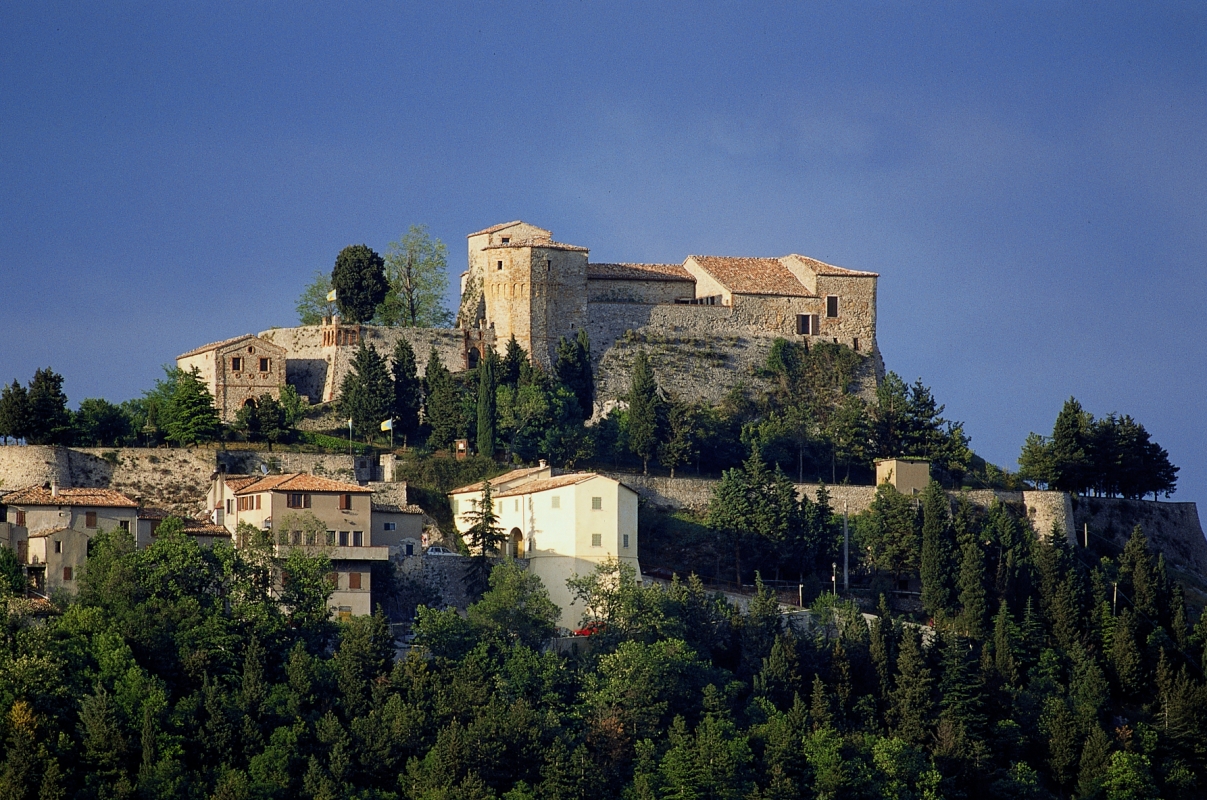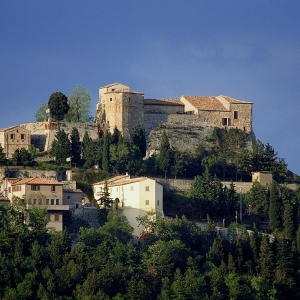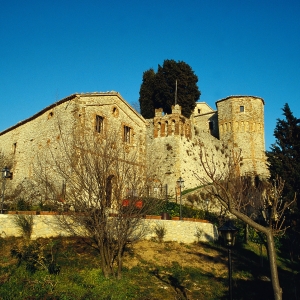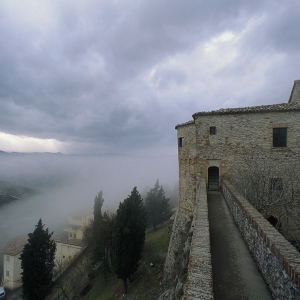Montebello Castle

Four-legged friends are welcome and will find a nice bowl of fresh water on arrival.
In the hinterland of Rimini, the Rocca di Montebello di Torriana elegantly dominates the Marecchia and Uso valleys, from a height of 436 metres: The fascinating journey through history, art and nature is made even more mysterious and magical due to the legendary presence of Azzurrina, that is Guendalina, the little girl with "... eyes the color of the sky and light-colored hair with blue reflections ..." who disappeared way back in 1375 and who still - according to fans of ghosts and the paranormal - reveals herself.
If the Rocca was in ancient times the scene of numerous battles, today it offers visitors the silent peace of a breathtaking and enchanting panorama.
Built in the year 1000 on the foundations of a Roman tower of the the 3rd century B.C., today it is divided into two wings, one from the Renaissance, the other one in the shape of a military fortress.
During the daytime guided tour - a historical itinerary in the Castle of Montebello suitable for all ages - you can see all the rooms of the manor and admire furniture ranging from 14th century to 19th century, manufactured as unique pieces (on display). Furthermore, the legend of Azzurrina is narrated with an explanation of the research carried out through the ages. The visit concludes with the recordings made from 1990 onwards.
The guided night tour is, on the contrary, only suitable for adults. It is not suitable for children. Above all, the aspect of the paranormal in the fortress is dealt with. It talks about the cruelest and darkest aspects of the Middle Ages.
A bit of history
Montebello is interesting from a historical point of view because its origins date back to pre-Roman times: it seems that the first inhabitants of this site were Celtic peoples and that, at the foot of the cliff, there seems to have been a place of worship for them. The first masonry construction dates back to Roman times (3rd century), a square-plan tower, now incorporated into the castle structure. The later early medieval settlement bore the Latin name Mons Belli (Mount of War).
The
first news of the castle is found in a notarial document dated 24 September 1186, when the castle was sold by Ugolinuccio di Maltalone to Giovanni Malatesta.
The Malatesta family provided the castle with fortifications, as it bordered the territory of the Montefeltro, historical
enemies of the Rimini family. In 1393, the Montefeltro, in a daring coup, succeeded in conquering the fortress. In 1438, Sigismondo Pandolfo Malatesta succeeded in recapturing it. But Malatesta's military fortunes declined until, in 1462, he was defeated at Pian della Marotta, near Senigallia, at the hands of the papal army sent by Pope Pius II (Piccolomini) and led by Federico da Montefeltro. Following the defeat, Montebello was enfeoffed in 1464, by the Counts Guidi di Bagno. [[MORE]]
Since then, the Conti Guidi family has still owned the fortress. After the 16th century, the fortress underwent interventions to adapt it as a noble residence. Compared to the structure of 1464, the Guidi restored an entire wing of the castle to a noble wing.
Between 1968 and 1973, the castle underwent major restoration work to restore the fortress from the extensive damage caused by bombing during the Second World War and became a museum in 1989. Since the same 1989, it has been open to visitors and is listed as a monument of Italian national heritage for its high historical value.
Ghost and legends
The story of Azzurrina is the story of Guendalina, a little girl with sky-blue eyes, daughter of a certain Ugolinuccio or Uguccione, feudal lord of Montebello, who in 1375 was the protagonist of a sad event. It was 21 June when, in the snowfields of the old Fortress, the little girl disappeared and was never found. This in a nutshell is her story, which was passed down orally for about three centuries and enriched with elements of fantasy. But why was she talked about so much?
We learn the reason from a Miscellany of tales from the Lower Marecchia Valley, the result of a 17th-century taste for popular fabulae. The pen of a 17th century story-teller thus stopped, on paper, the long flight of what was already a legend: Azzurrina.
"... she had sky-blue eyes and fair hair with blue highlights ...".
Hence Guendalina's nickname and its suggestion, from a 'real' phenomenon that, when seen more closely, turns out to be the result of a dye job gone wrong, because the child was born, in reality, with white hair: albino. The diversity of the other is something that not infrequently frightens man, today as in the past. Suspicion then, taken to the extreme, sometimes leads to the belief in extreme remedies. Eliminating the different and with it what it represents, can be seen as a solution.It was then, to defend (or hide) their daughter that her parents dyed her hair, but the white of albinism does not retain the colour, it reacts to the pigment by turning blue. Hence the 'strange' case and the appellation attached to it. And yet, the fascination it still exerts on the many visitors to the castle, on the producers of television programmes, on the merely curious, remains hidden in the arcane. What drives so many people to walk the winding roads of the millenary cliff, to finally reach the Rocca di Mons Belli? To find out, we take the seventeenth-century manuscript and continue reading:
"... and it is said that, at the end of the summer solstice of each lustre, a sound from that underground tunnel is still heard".
It is 1990, the castle has been open as a museum for barely a year, nevertheless, the legend is already in the public domain. There are those who blindly support it, those who dispute it, many fear it, others deride it, but everyone talks about it.
So, on 21 June of that year, sound engineers interested in such incidents make the first recordings. The equipment is sophisticated. All frequencies are recorded. In the studio, listening takes place: thunder, a violent downpour of rain, then... a sound. 1995. Still 21st June. New recordings. Same sound.Year 2000. Again 21st June. Again the summer solstice and, again, that sound repeating itself.Year 2005... and the legend continues to amaze scholars and researchers, images are added in the following years and the research continues... Tourists visiting the fortress are made to listen to all the recordings. Reactions remain the most diverse, if not conflicting. To some it sounds like a child's cry, to others a laugh, many say they hear a voice, distinguish a word, many others claim to hear nothing more or less than wind and rain in a thunderstorm.
Leaving interpretation free, everyone can form a personal judgement.
Copyright © Montebello di Torriana Castle








